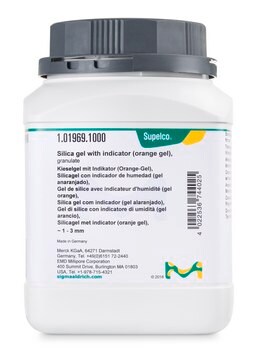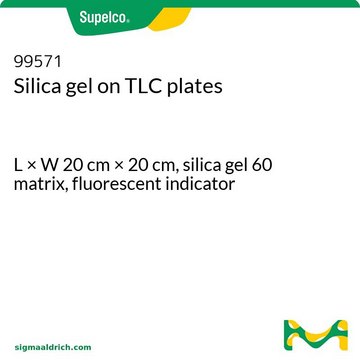60765
Gel de silice
high-purity grade, with ~15% calcium sulfate and fluorescent indicator, GF254, suitable for thin layer chromatography (TLC)
About This Item
Produits recommandés
Qualité
high-purity grade
with ~15% calcium sulfate and fluorescent indicator
Niveau de qualité
Forme
powder
Fabricant/nom de marque
Sigma-Aldrich
Technique(s)
thin layer chromatography (TLC): suitable
Superficie
500 m2/g
Taille des particules
<20 μm
>632 mesh
Dimension de pores
0.8 cm3/g pore volume
60 Å pore size
pb
2230 °C
Pf
>1600 °C
Chaîne SMILES
O=[Si]=O
InChI
1S/O2Si/c1-3-2
Clé InChI
VYPSYNLAJGMNEJ-UHFFFAOYSA-N
Vous recherchez des produits similaires ? Visite Guide de comparaison des produits
Description générale
a. Aquagel - pores are filled with water
b. Xerogel - by the process of evaporation, aqueous phase in the pores are removed
c. Aerogel - solvent is removed by supercritical extraction
Application
- Chromatographic Separation: Silica gel is widely used as a stationary phase in chromatography for the separation of various chemical compounds. Innovations in silica gel modification, such as pentabromobenzyl group-modified silica gel, have enhanced the separation efficiency for metabolites like nicotinamide. This application is critical for pharmaceutical analysis and metabolomics studies, providing high precision and accuracy in the quantification of biologically relevant molecules (Ozaki et al., Analytical Biochemistry, 2022).
- Environmental Pollutant Detection: Silica gel is used to create molecularly imprinted polymers (MIPs) that selectively recognize and bind environmental pollutants. A notable application involves the embedding of quantum dots in molecularly imprinted silica gel to detect aminoimidazo-azaarenes (AIAs) in food samples. This method offers high selectivity and sensitivity, making it a powerful tool for food safety and environmental monitoring (Qiao et al., Current Analytical Chemistry, 2021).
Produit(s) apparenté(s)
Code de la classe de stockage
11 - Combustible Solids
Classe de danger pour l'eau (WGK)
nwg
Point d'éclair (°F)
Not applicable
Point d'éclair (°C)
Not applicable
Équipement de protection individuelle
Eyeshields, Gloves, type N95 (US)
Faites votre choix parmi les versions les plus récentes :
Déjà en possession de ce produit ?
Retrouvez la documentation relative aux produits que vous avez récemment achetés dans la Bibliothèque de documents.
Les clients ont également consulté
Notre équipe de scientifiques dispose d'une expérience dans tous les secteurs de la recherche, notamment en sciences de la vie, science des matériaux, synthèse chimique, chromatographie, analyse et dans de nombreux autres domaines..
Contacter notre Service technique


